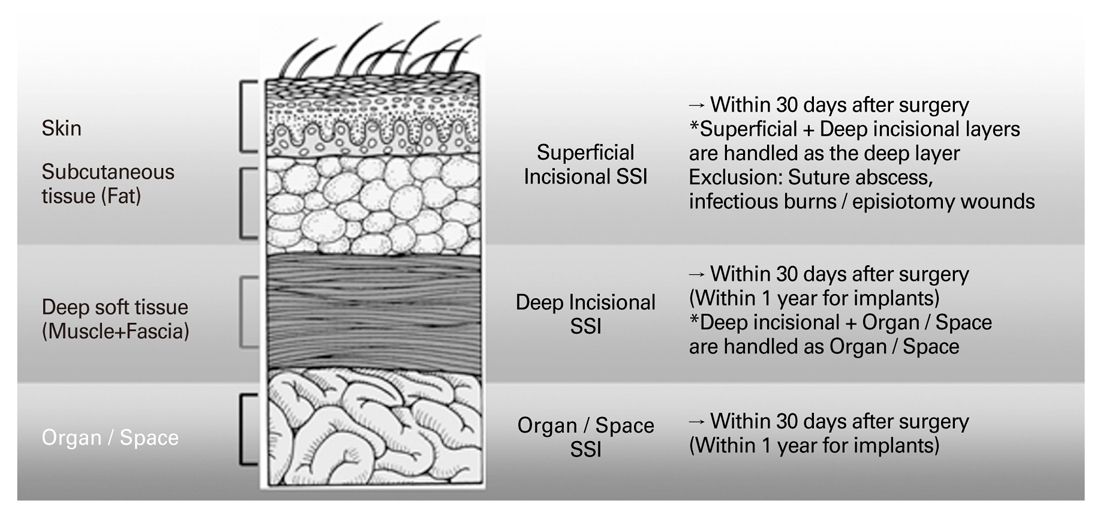J Korean Med Assoc.
2007 Oct;50(10):908-914. 10.5124/jkma.2007.50.10.908.
Surgical Site Infection and Surveillance
- Affiliations
-
- 1Department of Surgery, Keimyung University College of Medicine, Korea. tjlim@dsmc.or.kr
- KMID: 2065003
- DOI: http://doi.org/10.5124/jkma.2007.50.10.908
Abstract
- During the second half of the 19th century many operations were developed after anesthesia was introduced but advances were limited for many years because of the high rate of infection and the high mortality rate that followed infections. After the introduction of the principle of antisepsis, postoperative infectious morbidity decreased substantially. With the introduction of antibiotic therapy in the middle of the 20th century, a new adjunctive method to treat and prevent surgical infections was discovered. However, not only have postoperative wound and hospital required infections continued, but widespread antibiotic therapy has often made prevention and control of surgical infections more difficult. Based on National Nosocomial Infection Surveillance (NNIS) system reports, SSIs (Surgical Site Infections) are the third most common nosocomial infection, accounting for 14% to 16% of all nosocomial infections among hospitalized patients. It is also a significant source of postoperative morbidity, resulting in increased hospital length of stay and increased cost. Determination of risk factors for the development of SSI has been a major focus of surgical research. To reduce the rate of SSIs we have to eliminate risk factors of SSIs and keep a continuous surveillance with feedback of information to surgeons and other relevant staff. A successful SSI surveillance program includes standardized definition of infection, effective surveillance method, and stratification of the SSIs rates according to risk factors. Because SSIs may be the most preventable of nosocomial infections, health care facilities should make special efforts to reduce the risk of development of these surgical complications. The evaluation of infection control programs and the development of more effective infection control strategies should be established and surgeons should be more concern about SSI control.
Keyword
MeSH Terms
Figure
Reference
-
1. Mangram A, Horan TC, Silver LC, Jarvise WR. CDC guidelines for prevention of surgical site infection. Infection Control & Hospital Epidemiology. 1909. 20:247–269.2. Emori TG, Gaynes RP. An overview of nosocomial infections, including the role of the microbiology laboratory. Clin Microbial Rev. 1993. 6:428–442.
Article3. Leaper DJ, van Goor H, Reilly J, Petrosillo N, Geiss HK, Torres AJ, Berger A. Surgical Site Infection-A European Perspective of Incidence & Economic Burden. Int Wound J. 2004. 1:247–273.
Article4. Kathryn BK, Jane PB, Sharon LT, William EW, Daniel JS. The Impact of Surgical-Site Infections in the 1990s: Attributable Mortality, Excess Length of Hospitalization, and Extra Costs. Infection Control and Hospital Epidemiology. 1999. 20(11):725–729.
Article5. Edmiston CE, Seabrook GR, Goheen MP, Krepel CJ, Johnson CP, Lewis BD, Brown KR, Towne JB. Bacterial adherence to surgical sutures: Can Antibacterial-Coated Sutures Reduce the Risk of Microbial Contamination? J Am Coll Surg. 2006. 203:481–489.
Article6. Park ES, Kim KS, Lee WJ, Jang SY, Choi JY, Kim JM. The economical impacts of surgical site infection. Korean J Nosocomial Infect Control. 2005. 10:57–64.7. Horan TC, Gaynes RP, Martone WJ, Jarvis WR, Emori TG. CDC Definitions of Nosocomial Surgical Site Infections, 1992: A Modification of CDC Definitions of Surgical Wound Infections. Infect Control Hosp Epidemiol. 1992. 13:606–608.
Article8. Nooyen SM, Overbeek BP, Brutel de la Riviere A, Storm AJ, Langemeyer JM. Prospective randomised comparison of single-dose versus multiple-dose cefuroxime for prophylaxis in coronary artery bypass grafting. Eur J Clin Microbiol Infect Dis. 1994. 13:1033–1037.
Article9. Centers for Disease Control and Prevention. National Nosocomial Infections Surveillance (NNIS) report, data summary from October 1986-April 1996, issued May 1996. A report from the National Nosocomial Infections Surveillance (NNIS) System. Am J Infect Control. 1996. 24:380–388.10. Schaberg DR. Resistant gram-positive organisms. Ann Emerg Med. 1994. 24:462–464.
Article11. Jarvis WR. Epidemiology of nosocomial fungal infections, with emphasis on Candida species. Clin Infect Dis. 1995. 20:1526–1530.
Article12. Manian FA. Surveillance of surgical site infections in altenative settings: Exploring the current options. AJIC. 1997. 25(2):102–105.
Article13. Condon RE, Schulte WJ, Malangoni MA, Anderson-Teschendorf MJ. Effectiveness of a surgical wound surveillance program. Arch Surg. 1983. 118:303–307.
Article14. Center for Disease Control. Outline for surveillance and control of nosocomial infections. 1970. Atlanta: Center for Disease Control.15. National Nosocomial Infections Surveillance System. NNIS Report: National Nosocomial Infections Surveillance (NNIS) System Report, Data summary from January 1992-June 2002, Issued August 2002. American J Infect Control. 2002. 30:458–475.16. Central Public Health Laboratory. Surgical site infection analysis of year's surveillance in English hospitals, 1997-1998.17. Geubbles EL, Mintjes-de Groot AJ, vanden Berg JM, de Boer AS. An operating surveillance system of surgical-site infections in the Netherlands. Infect Control Hosp Epidemiol. 2002. 21:311–318.18. Lee SO. The 10th Training Course for Nosocomial Infection Control. Korean Society for Nosocomial Infection Control. 2006. 125–133.19. Kobayashi HY. Surgical Site Infection Surveillance. 2003. 1st ed. Medica;36–45.
- Full Text Links
- Actions
-
Cited
- CITED
-
- Close
- Share
- Similar articles
-
- Perspective of Nationwide Surveillance System for Surgical Site Infections
- Surgical Site Infection
- Surgical Site Infection Rates according to Patient Risk Index after Cardiovascular Surgery
- Current Status and Recent Changes in Nationwide Surveillance System for Surgical Site Infections
- Sensitivity of Laboratory-based Surveillance for Detecting Nosocomial Infections


